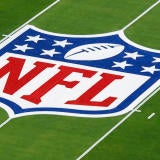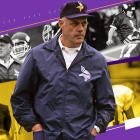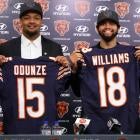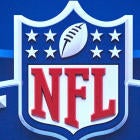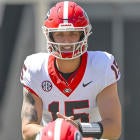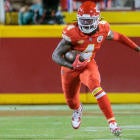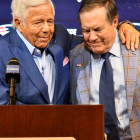Back in May the NFL writers and editors at CBSSports.com gathered together to discuss the key figures and moments of every NFL franchise in the Super Bowl era. Before long we were discussing every team's best and worst moments, along with their most-hated players and coaches, as well as some of the more bizarre things each team has been involved in. That spirited discussion produced this series -- the Good, Bad, Ugly and, sometimes, Bizarre moments for every team. We continue with the Minnesota Vikings.

The good
The Bud Grant era
To understand how Bud Grant became so popular in Minnesota, you first have to understand how ugly things were when Grant was hired in 1967. Basically the Vikings were a circus.
When Grant took over as head coach of the Vikings 49 years ago, things were looking pretty bleak in Minnesota. Grant was taking over for Norm Van Brocklin, a coach who was so sick of coaching that he actually quit the Vikings job twice in 15 months.
Van Brocklin resigned in November 1965, but this wasn't your normal resignation, because Van Brocklin would return the next week and coach the Vikings for 15 more months.
In February 1967, things got so ugly that quarterback Fran Tarkenton "quit" the team, which forced Van Brocklin to resign for a second time.
Carson Palmer's strategy to get out of Cincinnati in 2011 was basically invented by Tarkenton. Tarkenton swore he would never play for the Vikings again, so on March 7, 1967, the team traded him to the New York Giants.
Four days later, Grant was hired to coach a team that was in complete turmoil and had no starting quarterback. Not an ideal place to start for a first-time NFL head coach.
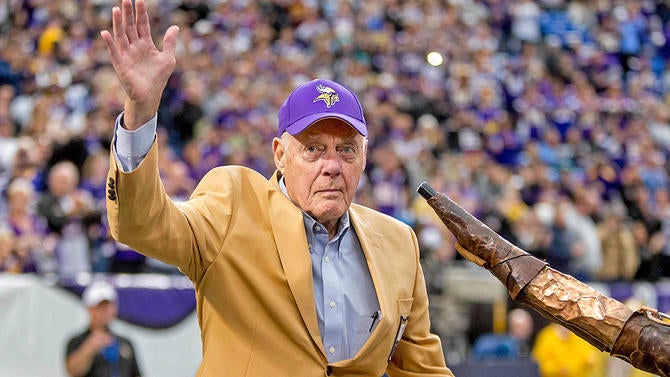
In his first month on the job, Grant fixed his first problem: He brought in a quarterback.
Grant and Vikings general manager Jim Finks had both spent some time in the CFL, so that's where they looked for their starting quarterback. The team brought in Joe Kapp, who had spent eight seasons in the CFL, a span that included two Grey Cup appearances and one championship with the British Columbia Lions.
The other big move Grant made came in the 1967 NFL Draft, which took place on March 14, just three days after he was hired. With the 15th overall pick, the Vikings selected Alan Page, a future Hall-of-Famer, who played a key role on the team's Purple People Eater defense.
Although the Vikings struggled to a 3-8-3 record during Grant's first season on the job, there wouldn't be much struggling after that. In 10 of his next 11 seasons with the team, Grant would lead the Vikings to the postseason. It was a ridiculous stretch that included three Super Bowl appearances in four years between 1973 and 1976.
Grant was successful despite the fact that there always seemed to be some sort of drama surrounding the team. After Kapp led the Vikings to a Super Bowl IV appearance in 1969, he decided to hold out for more money the following season. Kapp was asking for a five-year, $1.25 million deal, but the Vikings wouldn't give it to him.
Instead of giving money to Kapp, Grant decided to plug in Gary Cuozzo at quarterback and the team didn't miss a beat. Kapp would leave Minnesota and the Vikings would go to the playoffs in both years that Cuozzo was the team's starter.
Despite Cuozzo's success, Grant wasn't content, so he pulled off a shocker of a trade in January 1972: He brought Tarkenton back to Minnesota.
The combination of Tarkenton on offense and the Purple People Eaters on defense made the Vikings virtually unstoppable. Not only did they reach three Super Bowls in four years, but they also went to the NFC title game four times in five years (1973-1977).
It took a miracle from the Cowboys to keep the Vikings from going to five straight NFC title games. In a 1975 divisional playoff game, the Vikings lost 17-14 after Roger Staubach connected on a 50-yard touchdown pass with just 24 seconds left in the game.
Although Grant never won a Super Bowl, he's one of only eight coaches in NFL history to have made it to the big game four times.
After Grant retired in 1983, the Vikings fell apart. The team went 3-13 in 1984, which led the front office to make a wild offer to Grant: Come back and we'll give you a LIFETIME contract.
The internet would probably explode if an NFL coach got a lifetime contract today, but it's something that actually happened in 1985.
That's the kind of offer that's impossible to turn down, so Grant took it and returned to the Vikings sideline in 1985. One more season was enough though, and Grant retired again at the end of the year. It was almost fitting that he retired twice since he replaced a coach that had resigned twice.
Grant finished his Hall of Fame career with 158 regular seasons wins, which still stands as the 17th highest total in NFL history. During his career, Grant coached several players who would end up in the Hall of Fame, including: Paul Krause, Mick Tingelhoff, Ron Yary, Carl Eller, Tarkenton and Page.
Although Grant's been retired for over 30 years, he really hasn't slowed down much. The 89-year-old is still a popular figure in Minnesota, and he definitely loves the weather there. While most of us would get hypothermia if we walked out into freezing cold weather, that's not the case with Grant, who wore short-sleeves for the opening coin toss of the Vikings-Seahawks playoff game in January.
The temperature was negative-six degrees at kickoff (-20 windchill).
My favorite moment of #Vikings#Seahawks so far: 88-year-old Bud Grant in a polo #SkolVikespic.twitter.com/672k9LLoSq
— Ryan Kath (@ryankath) January 10, 2016
Even in retirement, Grant has endeared himself to the Minneapolis community. Grant's garage sale is pretty much the social event of the summer in Minnesota.
Former Vikings coach Bud Grant is having. Garage sale. Guess no Super Bowl rings are for sale! Ouch! Love the guy. pic.twitter.com/rwXXELh4B4
— Rich Lenz (@RichLenz6) May 20, 2016
The bad
Gary Anderson goes wide left in the NFC title game
The Vikings postseason history has basically been one giant nightmare for fans in Minnesota. Since the franchise's inception in 1961, the team has suffered shocking loss after shocking loss after shocking loss in the playoffs.
There's almost been so many shocking losses that we can't can even call them shocking anymore because it's just what you come to expect when the Vikings play in the postseason.
For a team that's lost four Super Bowls, it would be easy to say that one of those losses stung the most, but that's probably not the case for most Vikings fans. For most fans, the playoff loss that stung the most was probably 'The miss heard 'round the world:' Gary Anderson's 38-yard field goal that sailed wide left in the NFC title game.
After a 15-1 season in 1998, the Vikings looked like a surefire favorite to advance to Super Bowl XXXIII. Following a 41-21 divisional playoff win over the Cardinals, the only thing standing in the way of the Vikings and a Super Bowl berth was the Atlanta Falcons.
No one thought the Vikings were going to lose. Minnesota was an 11-point favorite and they were playing at home, where they had won 10 straight games, including the playoffs.
The blowout didn't happen though: With 2:11 seconds left, the Vikings were only leading 27-20.
After a Vikings' drive stalled on the Falcons' 21-yard line, Minnesota sent out Gary Anderson to attempt a 38-yard field goal that would have presumably iced the game.
What happened next will probably go down in NFL history as the most shocking miss of all-time.
Ouch.
Scott Norwood's might be the most famous miss of all-time, but Anderson's was the most shocking for one big reason: He hadn't missed a kick all season.
In 1998, Anderson became the first kicker ever to make it through an entire season without a miss: The Vikings kicker went 35-for-35 on field goals and 59-for-59 on extra points. Dating back to 1997, Anderson had made 122 consecutive kicks, which led pretty much everyone to believe that there was no way he was going to miss against the Falcons.
After the snap, Anderson's kick -- and the Vikings' Super Bowl hopes -- went wide left.
Although you can't completely blame Anderson for the loss, that's what people remember from the game. It's worth noting that the Falcons had to drive 71-yards in the final two-minutes to tie the game after Anderson's miss.
Even then, Minnesota could've still won.
The Vikings would get the ball twice in overtime, but they're high-scoring offense was never able to move the ball past their own 42-yard line.
The reason Anderson's miss hurts so much is because it effectively ended the season of the most successful Vikings team in franchise history. Randall Cunningham and Randy Moss led a Vikings offense that put up 556 points in 1998. That broke the NFL record at the time and still stands as the fifth-highest scoring season in NFL history.
The Vikings defense wasn't bad, either. They only gave up 18.5 points per game in 1998, which ranked sixth in the NFL.
Anderson's miss kept one of the best teams in NFL history from getting to the Super Bowl.
Although Anderson would go 9-of-9 on all his other postseason field goal attempts in Minnesota, no one really remembers any of those. Even worse, Anderson's name is one of the first ones that comes up when people have a conversation about the NFL's all-time greatest chokes.
Other "Bad" candidates:
Brett Favre's interception vs. the Saints. With 19 seconds left in the NFC title game after the 2009 season, Favre threw what might go down as his worst interception of all-time, which is saying a lot because Favre threw a lot of interceptions.
If Favre throws the ball out-of-bounds, the Vikings could've tried a 56-yard field game to win the game. If Favre scrambles and gets two or three yards, the field goal becomes a 53-yard attempt. Favre did neither of those things though, and instead, he threw an interception.
Blair Walsh's miss vs. the Seahawks. This wound's still fresh, so maybe we shouldn't talk about how Blair Walsh completely choked on a 27-yard field goal attempt to beat the Seahawks back in January.
The Vikings 1975 divisional playoff loss to the Dallas Cowboys. The term "Hail Mary" was basically invented in this game. The bad news for the Vikings is that they weren't the ones who threw it. Cowboys quarterback Roger Staubach hit Drew Pearson for a 50-yard touchdown with 24 seconds left to give Dallas a 17-14 win over the Vikings.
Anyway, I'll stop now. We don't need any Vikings fans having nightmares tonight.
The Ugly
Adrian Peterson child abuse scandal
It doesn't get much uglier than your star player being indicted on a charge of child abuse, but that's exactly what happened to the Vikings in 2014. Just five days after Minnesota's regular season opener, authorities in Texas announced that Peterson was going to be indicted for "reckless or negligent injury to a child."
The Vikings running back was accused of hitting his son with a switch as a way to discipline him. The beatings were allegedly so bad that they left lacerations on the boy's arms and legs.
Peterson's indictment was the beginning of a harrowing 10-month saga that didn't completely come to an end until July 2015. Shortly after the indictment, Peterson was placed on the NFL's Exempt/Commissioner's Permission List where he spent the next eight weeks.
Since he wasn't suspended yet, Peterson was able to collect the $690,000 game check for each of the eight games he missed.
On Nov. 4, 2014, Peterson pleaded no contest to a reduced charge of misdemeanor reckless assault. Under the plea, Peterson wasn't required to do any jail time, but he did have to pay a $4,000 fine. The running back was also sentenced to 80 hours of community service.
The saga didn't end there, though. Shortly after the plea deal, Peterson asked the NFL to reinstate him, but that didn't happen. Instead, NFL Commissioner Roger Goodell announced in a Nov. 18 letter that Peterson would be suspended for the rest of the 2014 season.

Peterson would appeal the suspension, only to lose again when an NFL arbitrator ruled against him in December. The Peterson decision led to a federal lawsuit by the NFLPA, which wasn't settled until March 2015 when a judge ruled in Peterson's favor. The ruling led to Peterson's reinstatement by the NFL in mid-April.
Although Peterson was reinstated, the NFL did appeal the decision made by the federal judge, and amazingly, that appeal is still going through the federal court system to this day (Unlike Tom Brady and Deflategate, Peterson's suspension won't be reinstated if his side loses the appeal).
Anyway, Peterson's reinstatement didn't even end this entire mess. The running back didn't like the way the Vikings treated him while he was suspended, so he demanded a trade. In May 2015, there was a thought that Peterson wanted out of Minnesota so badly that he'd be willing to retire if the Vikings didn't trade him.
In the end, the Vikings did something for Peterson that would make any player feel appreciated: They gave him more money. Peterson restructured his contract in July 2015, and the two sides have been at peace since then.
The bizarre
Fred Smoot's Love Boat
(Warning: Things get slightly vulgar below, read on at your discretion)
If there was one NFL sex scandal that had it all, this was it.
Sex? Check.
Sex toys? Check.
Naked women? Check.
Roughly thirty Vikings players? Check.
The Love Boat legend was born on Oct. 6, 2005 when Fred Smooth and teammate Lance Johnstone decided to charter two giant boats for a cruise on Lake Minnetonka. Instead of holding the cruise during the offseason though, the duo decided to do it during the Vikings' bye week.
What transpired next is the stuff of legend.
The crew that was working on the two love boats didn't think anything weird was going on until a few minutes after they left dock. At that point, many of the females onboard started "going down into a lower restroom area and changing out of the clothes that they had been wearing when they got on the boat, and were emerging either scantily clad or nearly naked."
According to police reports that were filed after the incident (via The Smoking Gun), Smoot was seen using a sex toy on two women. Quarterback Daunte Culpepper was on the receiving end of a lap dance from a naked woman. Another witness saw Bryant McKinnie perform oral sex on a female while she sat on a bar counter -- an act that Smoot later referred to as "running through the okra patch."
Urban dictionary liked Smoot's description so much that they now use it.
The crazy thing is that all of this happened in a span of just one hour. The cruise was supposed to be three and a half hours long, but it was cut short when the charter captains decided to end things because the situation was getting too crazy.
We'll likely never know all the details of the Love Boat, so let's just be happy with the ones we have.
Two months after the scandal, four Vikings players were charged for the incident. Culpepper, Smoot, McKinnie and Moe Williams were all hit with the same three chargers: Indecent conduct, disorderly conduct and lewd or lascivious conduct.
Ironically enough, it seems that the Love Boat brought the team together. The Vikings were 1-3 before the Love Boat incident, but would go 8-4 over the season's final 12 games and finish second in the NFC North.
The dramatic improvement didn't help coach Mike Tice though. He was fired after a 9-7 season.
Of course, Tice only had himself to blame for his firing because he was embroiled in his own scandal. In early 2005, the NFL found out that Tice was scalping Super Bowl tickets. The league fined him $100,000 after Tice promised to never do it again.









